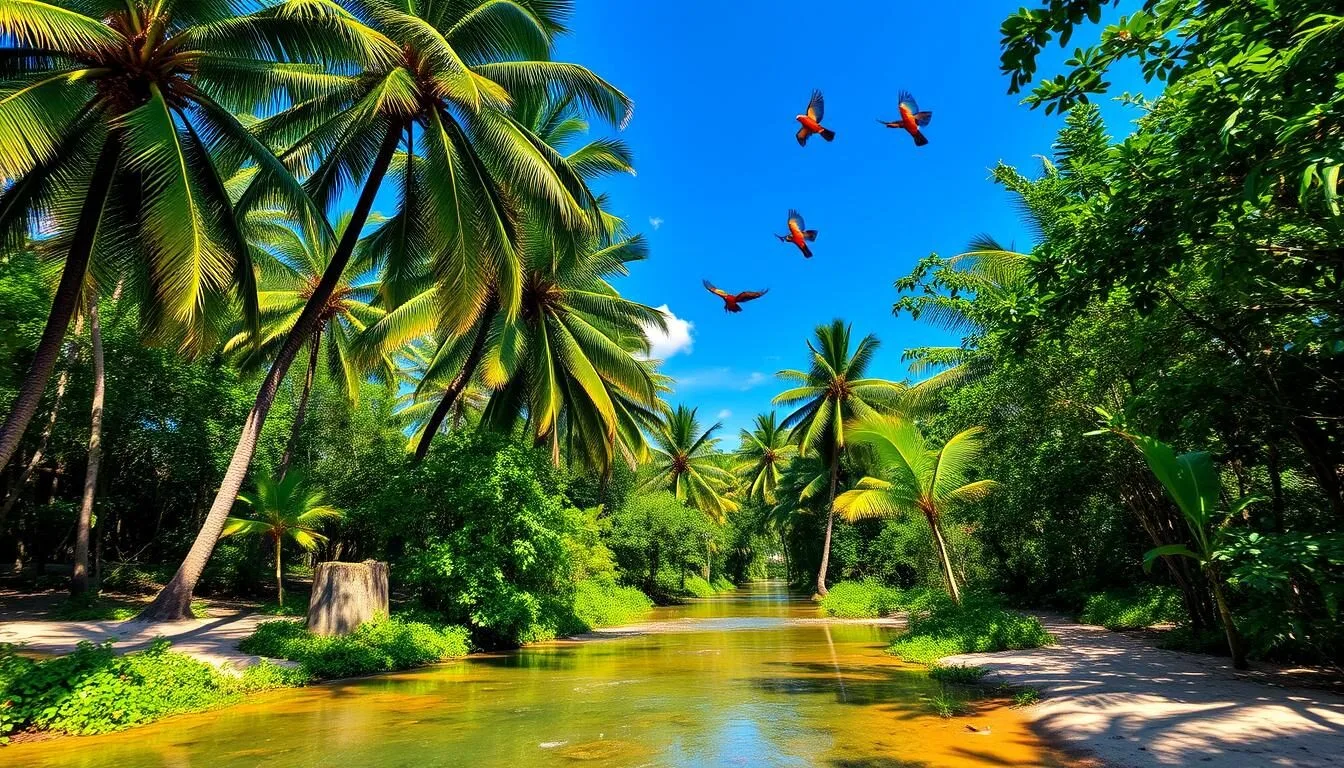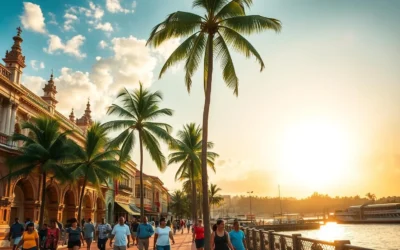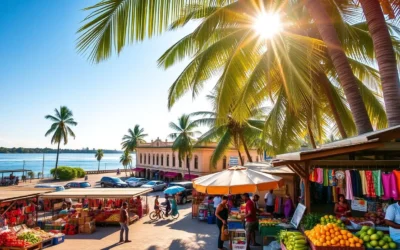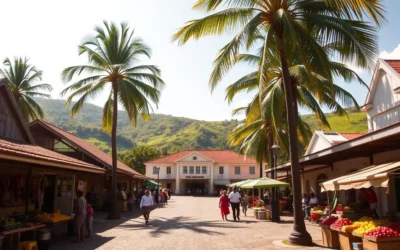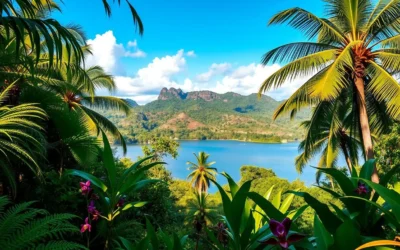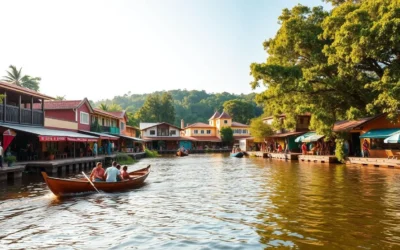✓ Accommodations✓ Flights✓ Rental Cars
Nestled in the northeastern corner of Suriname, where the Marowijne River meets the Atlantic Ocean, lies the breathtaking Galibi Nature Reserve. This haven is a crucial nesting ground for four rare species of sea turtles, including the majestic leatherback turtle.
As you explore this hidden gem of South America, you’ll experience a unique blend of nature and culture. Unforgettable encounters with wildlife and the indigenous Kaliña people await you in this remote paradise.
From witnessing the majestic sea turtles to exploring the lush mangroves, you’ll discover why Galibi should be on your travel bucket list. Get ready to immerse yourself in the top activities and attractions that make Galibi a must-visit destination.
Discovering Galibi: Suriname’s Hidden Gem
Located where the Marowijne River meets the Atlantic Ocean, Galibi is a unique destination that combines natural beauty and cultural richness. This remote area in the northeastern corner of Suriname is a treasure trove of unspoiled environments and diverse wildlife.
Galibi is nestled at the border between Suriname and French Guiana, with the Marowijne River serving as a natural boundary between the two countries. The river not only separates but also connects these two nations, facilitating the transport of goods and people. The area is accessible primarily by boat from the town of Albina, making the journey to Galibi an adventure in itself as you travel along the scenic river.
Where is Galibi Located?
Galibi is situated in the northeastern corner of Suriname, a country in South America. The Marowijne River forms the boundary between Suriname and French Guiana, creating a unique ecosystem where the river meets the Atlantic Ocean. This location has preserved Galibi’s natural beauty and cultural authenticity, making it one of the world’s most unspoiled coastal environments.
The cultural and political affiliations of Suriname with Caribbean nations add to Galibi’s fascinating blend of influences, setting it apart from other destinations in the region. As you explore Galibi, you experience the rich cultural heritage and breathtaking natural landscapes that make it a truly special place.
How to Get to Galibi, Suriname
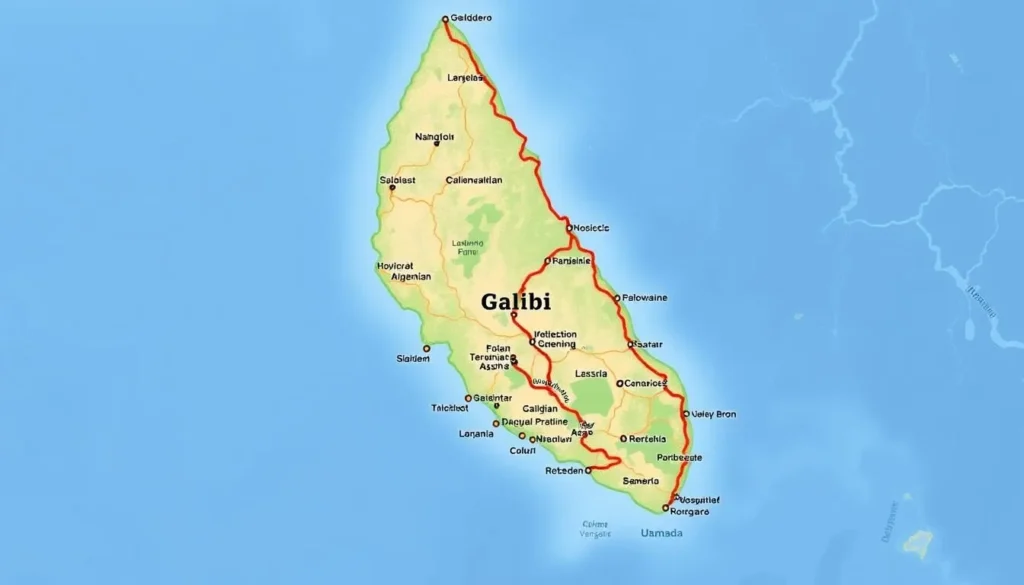
The journey to Galibi, Suriname, begins with international travel to Suriname, followed by domestic arrangements. To start, you’ll need to fly into Suriname’s Johan Adolf Pengel International Airport.
Reaching Suriname from International Destinations
Reaching Suriname requires some planning as there are no direct flights from most countries. Most international travelers arrive via Amsterdam, Netherlands, or connecting flights through Caribbean hubs like Aruba or Curaçao.
Johan Adolf Pengel International Airport is located about 45 kilometers south of Paramaribo, the capital city. To continue your journey to Galibi, you’ll need to plan for ground transportation to Albina, which serves as the gateway for boat trips to Galibi.
- Your journey to Galibi begins with an international flight to Suriname’s Johan Adolf Pengel International Airport, located about 45 kilometers south of the capital city, Paramaribo.
- Most international travelers reach Suriname via connecting flights through Amsterdam, Netherlands, or Caribbean hubs like Aruba or Curaçao, as direct flights from most countries are limited.
- Once in Paramaribo, you’ll need to plan for ground transportation to Albina, which serves as the gateway for boat trips to Galibi.
- Many tourist agencies in Paramaribo offer organized day trips to Galibi, which can simplify your planning process if you prefer not to arrange transportation independently.
- Entry requirements for Suriname include a valid passport with at least six months validity, a return ticket, and for many nationalities, a tourist card or visa that you should arrange before your trip.
By understanding these steps and planning accordingly, you can ensure a smooth journey to Galibi, Suriname, and enjoy the natural beauty and unique experiences this destination has to offer.
Transportation from Paramaribo to Galibi
To reach Galibi, you’ll first need to travel from Paramaribo to Albina by road, followed by a boat ride along the Marowijne River. This journey is not just about getting from one place to another; it’s an experience that offers a glimpse into Suriname’s diverse landscapes and cultures.
From Paramaribo, you’ll need to take a bus or taxi to the town of Albina, which is approximately a 3-hour journey along Suriname’s eastern coastal road. The road trip itself is quite scenic, offering views of the Surinamese countryside.

Once you arrive in Albina, you’ll find boat operators at the riverfront who provide transportation services to Galibi. The boat trip takes approximately 1-2 hours along the scenic Marowijne River, during which you’ll pass by several indigenous villages. This part of the journey is particularly enriching as you get to witness daily life along this important waterway.
Many visitors opt for organized day trips from Paramaribo that include round-trip transportation, making the journey more convenient, albeit slightly more expensive than independent travel. It’s advisable to arrange your boat trip in advance, especially during the peak turtle nesting season when demand for transportation to Galibi increases significantly.
By planning ahead and choosing the right transportation options, you can ensure a smooth and enjoyable journey to Galibi. Whether you prefer the convenience of a guided tour or the flexibility of independent travel, there are options available to suit your needs.
Best Time to Visit Galibi
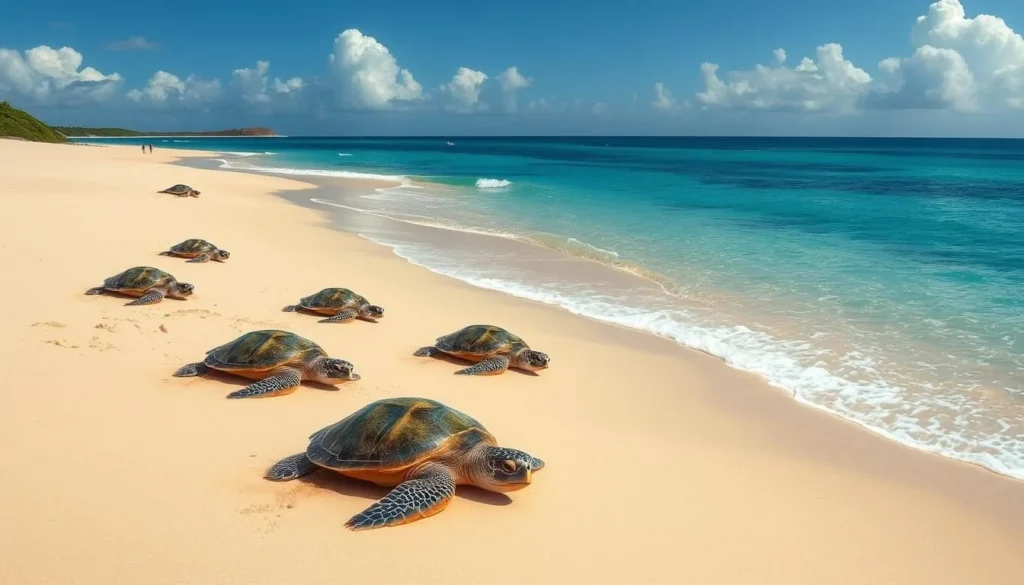
Visiting Galibi Nature Reserve is a unique experience, especially when you time it right with the sea turtle nesting season. The reserve comes alive during this period, offering visitors a chance to witness a natural spectacle.
Turtle Nesting Season (April to August)
The prime time to visit Galibi is during the turtle nesting season, from April to August. During this time, female sea turtles come ashore to lay their eggs on the beaches. These eggs usually hatch after a two-month incubation period in the deep sand.
The turtle nesting season is a critical period for several endangered turtle species, including the massive leatherback turtle, which can weigh up to 700 kg when fully grown. Witnessing these gentle giants is a thrilling experience for visitors.
- The prime time to visit Galibi is during the turtle nesting season from April to August, when you can witness the spectacular sight of female sea turtles coming ashore to lay their eggs.
- During this period, Galibi’s beaches become crucial nesting grounds for several endangered turtle species.
- If you’re lucky, you might also witness the magical moment when turtle hatchlings emerge from their eggs after the two-month incubation period and make their perilous journey to the ocean.
- While the turtle nesting season draws the most visitors, each time of year offers different wildlife viewing opportunities in Galibi’s diverse ecosystems.
- Consider the regional weather patterns when planning your visit, as the rainy season can make transportation more challenging, though it also brings lush vegetation and fewer crowds.
Planning your visit according to the turtle nesting season can enhance your experience, but it’s also worth considering the other unique aspects of Galibi throughout the year.
Weather Considerations and Seasonal Activities
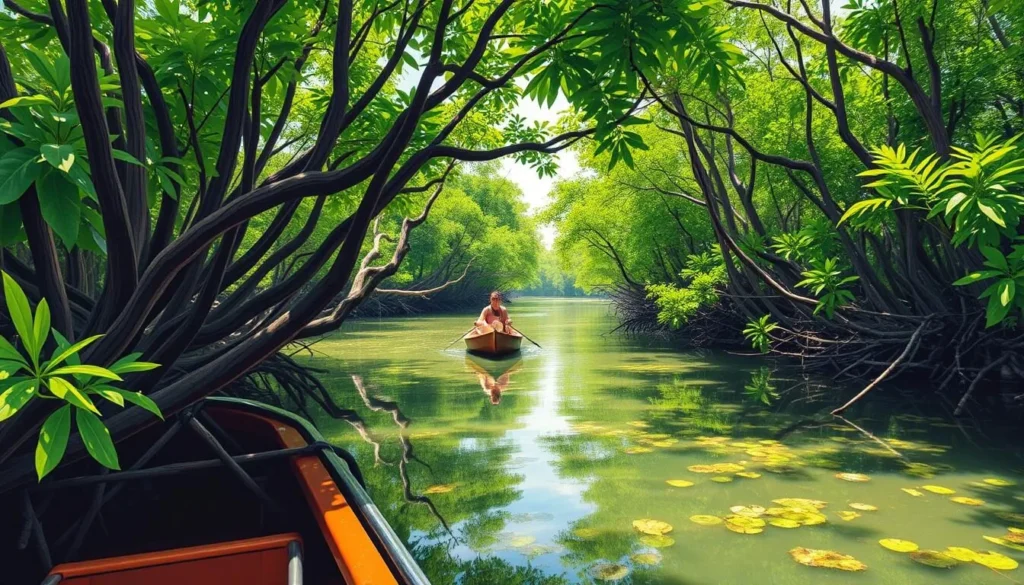
Understanding the weather patterns in Galibi is crucial for planning your activities. Galibi experiences a tropical climate with consistently high temperatures year-round, averaging between 29-34°C (84-93°F), so you’ll want to pack lightweight, breathable clothing regardless of when you visit.
The area follows Suriname’s pattern of two dry seasons and two rainy seasons, with the long dry season from mid-August to mid-November offering the most reliable weather for outdoor activities like mangrove tours. During this time, you’ll enjoy higher temperatures but avoid the heavy rains that can make travel difficult, especially to interior regions.
During the rainy seasons, particularly May to July, water levels rise and some trails may become muddy or inaccessible, though the lush vegetation during this time creates spectacular scenery. Each season brings different wildlife viewing opportunities, with bird watching particularly rewarding during the migration periods and water-based activities more enjoyable during the dry seasons.
If you’re planning a trip focused on photography, the quality of light during the dry season and the clearer skies make this the optimal time for capturing Galibi’s natural beauty in the area.
Witness Sea Turtle Nesting – A Magical Experience

Witnessing the majestic sea turtles nesting in Galibi is an experience that will leave you in awe. The Galibi Nature Reserve is famous for its sea turtle nesting sites, where between April and August, visitors can witness giant leatherback, green, and olive ridley turtles coming ashore to lay their eggs—a truly unforgettable wildlife experience in the world.
Conservation Significance
The reserve provides critical nesting habitat for several endangered species, including the massive leatherback turtle, which is the largest of all living turtles and can reach weights of up to 700 kg. During nesting season, female leatherbacks emerge from the ocean under the cover of darkness, laboriously making their way up the beach to dig nests where they’ll deposit around 80-100 eggs.
The critically endangered leatherback turtle has existed in its current form for over 100 million years, making your encounter with these prehistoric creatures a truly humbling experience. The nature reserve plays a vital role in protecting these magnificent creatures, as female turtles return to the same beaches where they were born to lay their own eggs, continuing a cycle that has persisted for millennia.
- Witnessing the ancient ritual of sea turtle nesting in Galibi Nature Reserve is one of the most awe-inspiring wildlife experiences in the world.
- The reserve provides critical nesting habitat for several endangered turtle species, including the massive leatherback turtle.
- During nesting season, female leatherbacks emerge from the ocean under the cover of darkness to lay their eggs.
- The critically endangered leatherback turtle has existed for over 100 million years, making encounters with them humbling.
- Galibi’s conservation efforts are crucial in protecting these magnificent creatures.
Turtle Watching Tours and Guidelines

Turtle watching in Galibi is a carefully managed experience that allows visitors to observe these magnificent creatures up close. As the nesting ground for four rare species of sea turtles, including the leatherback turtle, Galibi offers a unique opportunity to witness this natural phenomenon.
Turtle watching tours in Galibi are carefully regulated to minimize disturbance to the nesting turtles. Local guides, knowledgeable about turtle behavior and conservation efforts, lead these tours. You’ll need to join an organized tour to observe the turtles, as independent access to nesting beaches is restricted to protect these endangered species and their critical habitat.
Tours typically depart in the evening hours when turtles are most likely to come ashore. You may need to be patient, as nature operates on its own schedule, not tourist timetables. Your guide will provide specific guidelines to follow during your turtle watching experience, including maintaining a safe distance, avoiding flash photography, and keeping noise to a minimum.
By participating in responsible turtle watching trips, you’re directly contributing to conservation efforts in Galibi. A portion of tour fees supports protection and research programs for these magnificent creatures, making your visit a valuable part of their preservation.
Conservation Efforts and Responsible Tourism
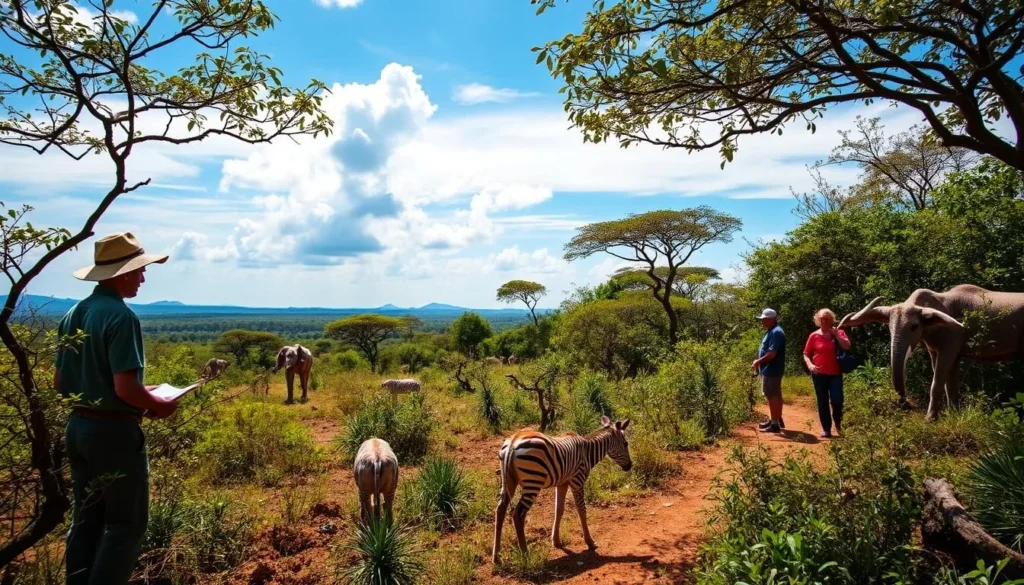
Galibi Nature Reserve is a testament to the power of collaborative conservation efforts. Established as part of an international joint effort to protect endangered marine animals, this reserve plays a crucial role in safeguarding the future of several species.
The conservation work in the Galibi Nature Reserve involves a synergy between government agencies, international organizations, and the local Kaliña population. The Kaliña people have traditional ties to this land, and their involvement is vital for the success of conservation initiatives.
Some of the key conservation efforts include:
– Protecting the nature reserve as a safe haven for endangered marine species, particularly the sea turtles that depend on these beaches for reproduction.
– Monitoring population trends and protecting nesting sites from predators and poachers.
– Conducting research to better understand these endangered species and inform conservation practices.
Responsible tourism practices are essential when visiting the area. The delicate ecosystem and the wildlife it supports are vulnerable to human disturbance. By following guidelines during your visit, such as staying on designated paths and respecting wildlife viewing distances, you help ensure that Galibi’s natural treasures remain protected for future generations.
The conservation initiatives in Galibi are a shining example of how collaborative efforts can lead to significant positive change. By supporting these efforts through responsible tourism, visitors can contribute to the ongoing protection of this unique area and its inhabitants.
Exploring the Coastal Mangroves
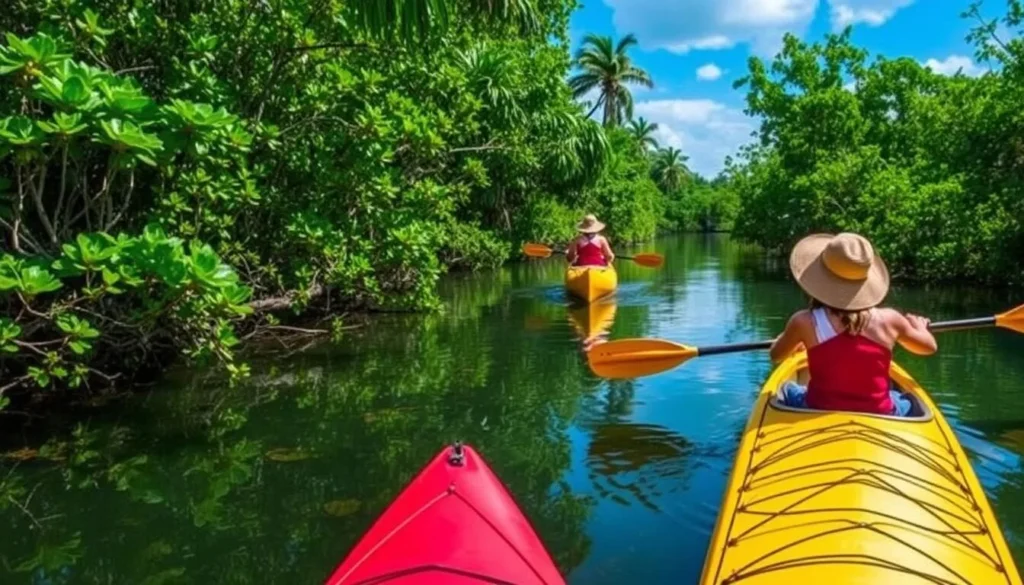
As you venture into Galibi, the coastal mangroves await your exploration. The mangrove ecosystems here are vital for wildlife and offer stunning views. Kayaking through these areas lets you spot birds and other wildlife while enjoying the serene environment.
Kayaking Through Mangrove Ecosystems
Exploring Galibi’s extensive coastal mangroves by kayak offers you an intimate perspective of this unique ecosystem that serves as a crucial transition zone between land and water. Guided kayaking activities take you through narrow waterways beneath the arching roots of mangrove trees, where you can observe wildlife from a quiet, non-intrusive vantage point.
- The mangrove ecosystem acts as a natural nursery for countless marine species and provides essential habitat for birds, making it a hotspot for nature observation and photography.
- As you paddle through the tranquil waters, your guide will point out the different mangrove species and explain their vital ecological role in protecting the coastline and filtering water.
- This trip is suitable for most fitness levels and provides a refreshing alternative to jungle hikes, allowing you to experience Galibi’s biodiversity from a different perspective.
By engaging in kayaking activities within the mangroves, you not only get to enjoy the serene nature but also contribute to the conservation efforts by promoting eco-tourism. This makes your trip to Galibi both memorable and impactful.
Flora and Fauna of Galibi’s Mangroves
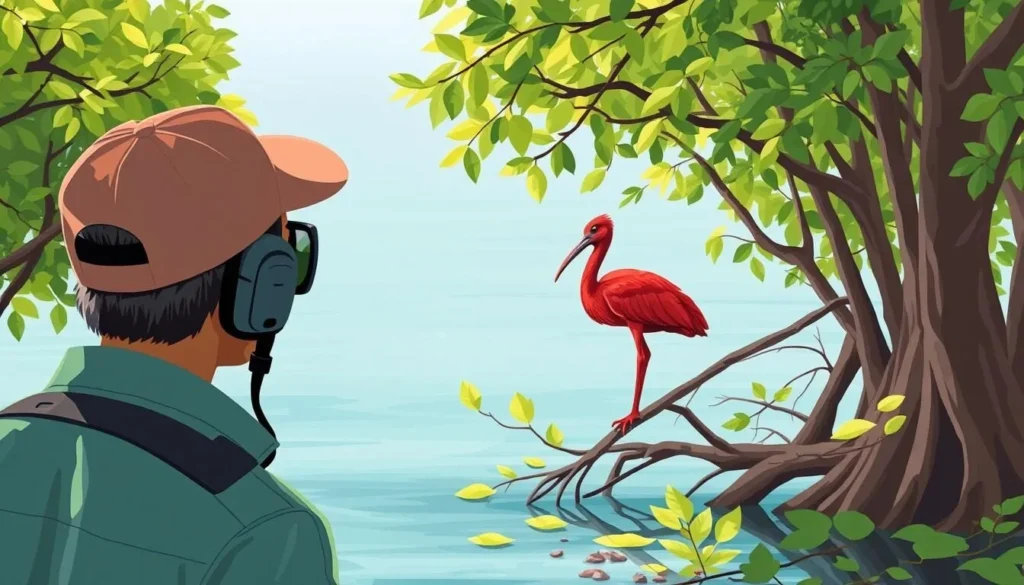
As you explore Galibi’s mangroves, you’ll discover a world teeming with life. The mangrove ecosystem acts as a natural nursery for countless marine species and provides essential habitat for birds. Galibi’s mangrove forests represent one of the most productive ecosystems in the world, supporting an incredible diversity of plant and animal species adapted to life in this challenging environment.
Four main species of mangroves can be found in the area, each occupying a specific zone based on their tolerance to saltwater and tidal fluctuations. The complex root systems of mangroves provide shelter for juvenile fish, crustaceans, and other marine life, making these forests crucial for maintaining healthy fish populations in the surrounding waters.
Birdwatching tours in Galibi offer a chance to spot various bird species, including the striking scarlet ibis, various herons and egrets, and if you’re lucky, the elusive mangrove cuckoo. The transition zone between mangroves and inland jungle creates a unique ecotone where diverse plant communities thrive, including orchids and bromeliads that grow as epiphytes on mangrove branches, showcasing the beauty of nature.
The intricate network of mangroves and the adjacent jungle provides a rich tapestry of habitats for a wide range of flora and fauna, making Galibi a paradise for nature enthusiasts and birdwatchers alike.
Wildlife Spotting in Galibi Nature Reserve
Galibi Nature Reserve is a paradise for nature lovers, with its rich biodiversity and varied habitats. The reserve is home to a diverse range of wildlife, including monkeys, jaguars, and a variety of bird species.
With over 250 bird species, including toucans and parrots, birdwatching here is a dream for enthusiasts. The varied habitats, from coastal areas to inland forests, support different species assemblages, giving you the opportunity to observe a wide range of wildlife during your visit.
Bird Species to Look For
The Galibi Nature Reserve is particularly renowned for its avian diversity. Some of the notable bird species you can expect to see include:
- Colorful toucans, known for their distinctive beaks
- Parrots, adding vibrant splashes of color to the landscape
- The striking scarlet ibis, with its brilliant red plumage
Early morning is the best time for wildlife spotting, when the forest comes alive with activity and many species emerge to feed before the heat of the day sets in.
Guided wildlife spotting trips are available for day visitors or those staying longer, with knowledgeable local guides who can help you identify species and find the best observation spots.
Patience and quiet observation are key to successful wildlife spotting in Galibi, as many animals are shy and will retreat at the first sign of human disturbance.
Mammals and Reptiles in the Reserve
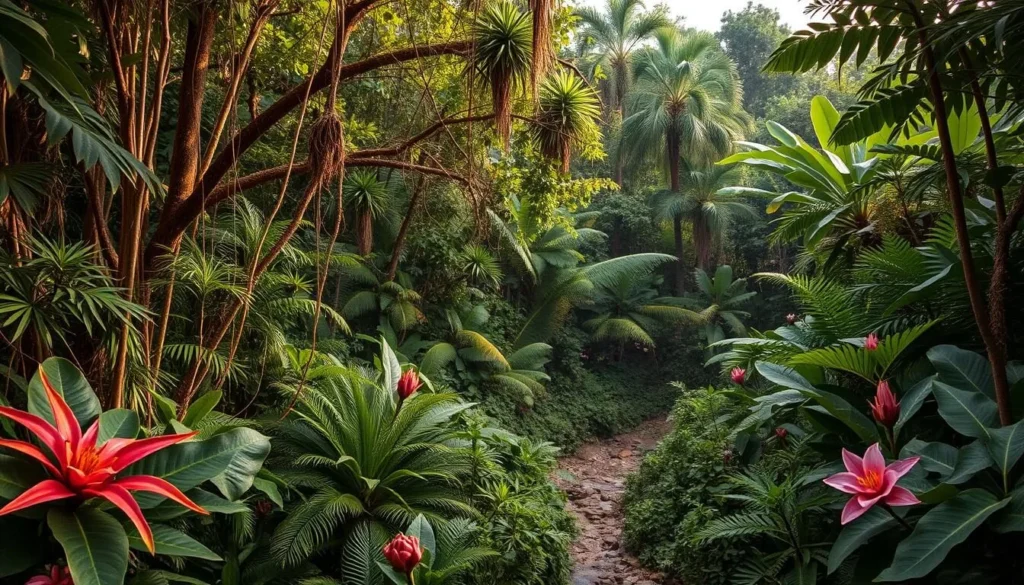
Within the Galibi Nature Reserve, a fascinating world of mammals and reptiles awaits discovery, from the canopy-dwelling monkeys to the riverbank-sunning caimans. The reserve is home to a diverse range of wildlife, including monkeys, jaguars, and a variety of bird species.
Beyond its famous sea turtles, Galibi Nature Reserve hosts an impressive diversity of mammals, including several monkey species that you might spot swinging through the canopy during day hikes. While elusive, larger mammals such as jaguars, ocelots, and tapirs inhabit the more remote areas of the reserve, and though rarely seen, you might discover their tracks along muddy trails.
The reserve’s reptile population includes various snake species, iguanas, and caimans that can often be spotted sunning themselves along riverbanks during boat trips. Different habitats within the reserve support distinct mammal communities, from the jungle-dwelling howler monkeys to the semi-aquatic capybaras that frequent wetland areas.
Night walks with experienced guides offer opportunities to spot nocturnal species that remain hidden during daylight hours, adding another dimension to your wildlife viewing experience. This variety of species and the opportunity to see them in their natural habitat make the Galibi Nature Reserve a unique destination.
Best Spots for Wildlife Photography
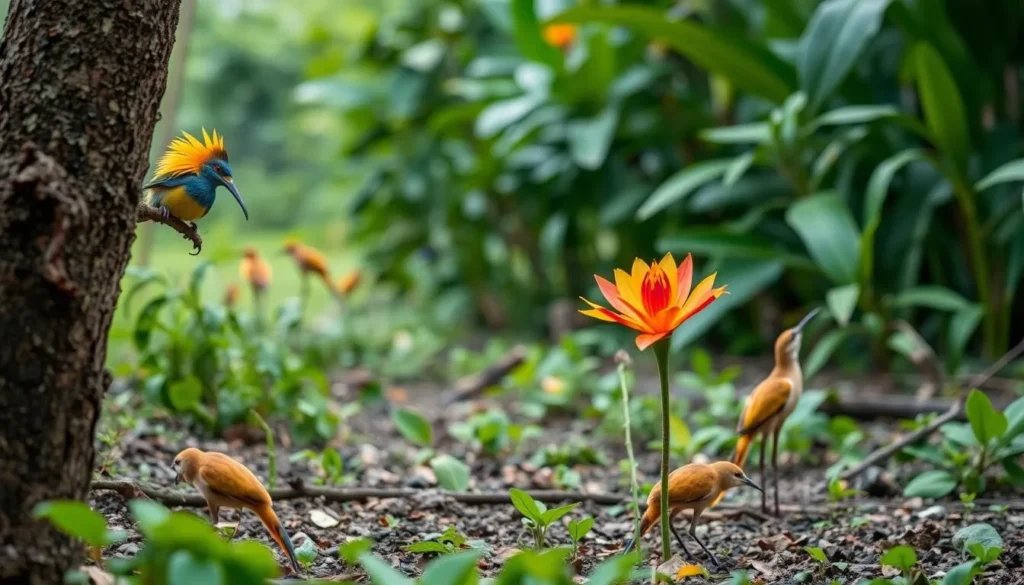
Galibi offers a photographer’s paradise with its rich biodiversity. The area is teeming with life, making it an ideal location for a day trip or a longer nature excursion.
For the best wildlife photography opportunities in Galibi, head to the observation platforms overlooking the wetland areas during early morning or late afternoon when animals are most active. The time of day is crucial for capturing stunning images.
The junction where mangroves meet the forest edge creates a productive ecotone that attracts diverse wildlife, making it a prime area for photography throughout the day. Consider including a boat trip in your itinerary to access otherwise difficult-to-reach areas.
River edges provide excellent vantage points for capturing both aquatic species and animals that come to drink, especially during the dry season when water sources are more concentrated. On your trip, be sure to visit these spots for unique photographic opportunities.
The beaches during turtle nesting season offer once-in-a-lifetime photography opportunities, though you’ll need to follow strict guidelines about lighting and distance to avoid disturbing these endangered creatures.
Hiking Trails in and Around Galibi
As you explore Galibi, you’ll discover a network of hiking trails that weave through the lush rainforest, offering a chance to connect with nature. These trails are designed to provide an immersive experience, allowing you to witness the diverse flora and fauna that this region has to offer.
The trails in Galibi are well-marked and cater to different fitness levels, ensuring that everyone can enjoy the beauty of this nature reserve. Whether you’re looking for a leisurely stroll or a more challenging hike, Galibi has something for you.
The Galibi Nature Reserve Trail
One of the most popular hiking trails in Galibi is the Galibi Nature Reserve Trail. This 5-kilometer trail is estimated to take about 2-3 hours to complete and is considered to have an easy to moderate difficulty level. The trail features stunning coastal views, opportunities for birdwatching, and the chance to see nesting turtles during the seasonal months.
The terrain along this trail consists of sandy paths and forested areas, making it a great way to experience the natural beauty of Galibi. Along the way, you’ll encounter informative signage that highlights points of interest and provides context about the area’s ecology, conservation efforts, and the history of the indigenous villages.
- The trail offers an accessible 5-kilometer hiking experience through diverse habitats, from coastal vegetation to inland forest.
- Informative signage along the trail provides insights into the area’s ecology and the history of the indigenous villages.
- The relatively flat terrain makes this trail suitable for most fitness levels, though proper footwear is recommended.
- Guided hikes are available and highly recommended for first-time visitors to enhance your experience.
- Connecting trails lead to nearby indigenous communities, offering a chance to learn about traditional ways of life.
| Trail Feature | Description |
|---|---|
| Distance | 5 kilometers |
| Duration | 2-3 hours |
| Difficulty Level | Easy to Moderate |
| Terrain | Sandy paths and forested areas |
| Highlights | Coastal views, birdwatching, nesting turtles (seasonal) |
For those planning a longer trip, the connecting trails offer a unique opportunity to explore the nearby indigenous communities. Here, you can learn about the traditional ways of life and perhaps purchase handcrafted souvenirs directly from artisans.
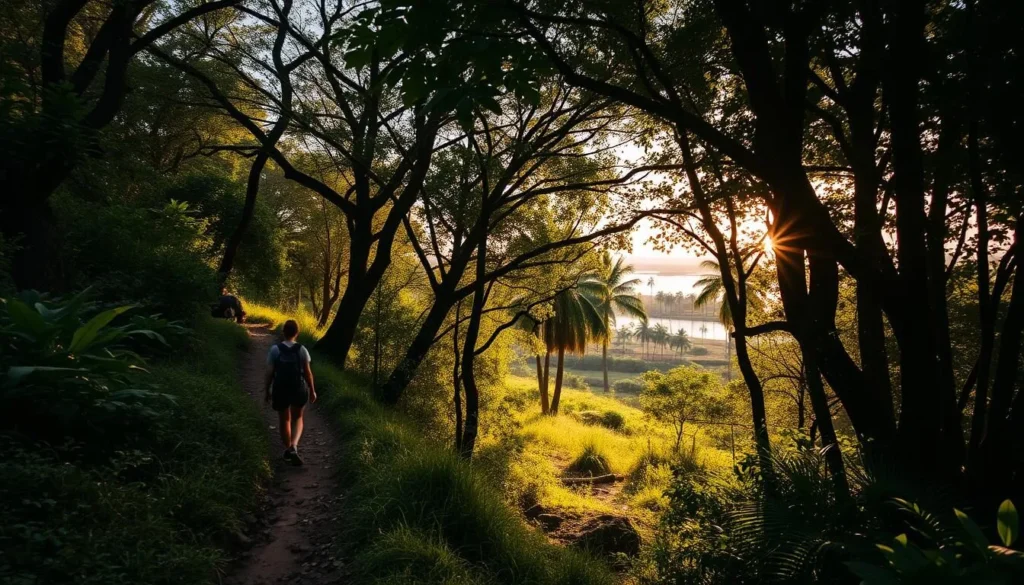
Whether you’re a seasoned hiker or just looking for a leisurely walk, the hiking trails in Galibi offer an unforgettable experience. With its diverse habitats, rich biodiversity, and stunning natural beauty, Galibi is a must-visit destination for nature lovers and adventure seekers alike.
What to Pack for Hiking in Galibi
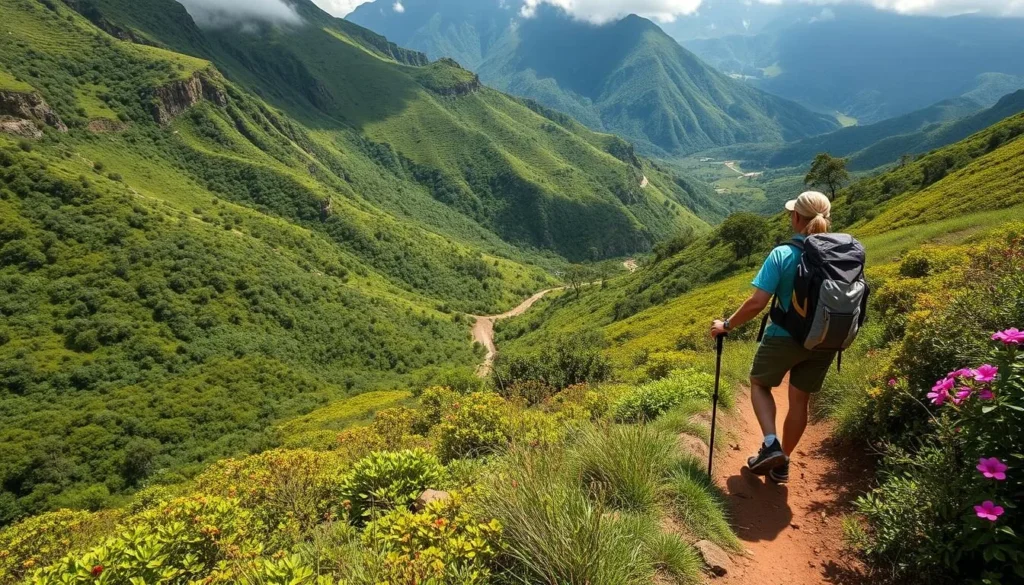
To ensure a safe and enjoyable hiking experience in Galibi, packing the right essentials is key. The tropical climate and potential for sudden rain showers make it crucial to choose your gear wisely.
When preparing for your trip to Galibi, consider packing lightweight, quick-drying clothing. Avoid heavy fabrics like jeans, as they can be uncomfortable in the humid climate. An ultralight rain/wind jacket is also a must-have to keep you dry in case of unexpected rain.
Staying hydrated is vital, so always carry sufficient water for your hike. For longer days on the trail, consider bringing a water purification system to ensure you have access to clean drinking water at all times.
Protecting yourself from the sun and insects is also crucial. Use high-SPF sunscreen and lip balm to prevent sunburn, and don’t forget insect repellent containing DEET to keep mosquitoes and other biting insects at bay. Given the intense equatorial sun, even on cloudy times, sun protection is not just a recommendation but a necessity.
Immerse in Indigenous Kaliña Culture
As you explore Galibi, you’ll have the opportunity to immerse yourself in the rich culture of the indigenous Kaliña people. The Galibi Reserve is part of a region inhabited by the Kaliña people, who have maintained their distinct cultural identity for centuries.
Visiting the neighboring villages offers an authentic glimpse into Kaliña cultural heritage. You can learn about indigenous culture directly from community members who are often willing to share aspects of their traditional knowledge and daily life.
Meeting the Kaliña People
The Kaliña population in this region has preserved many traditional practices while adapting to modern influences, creating a fascinating cultural landscape that bridges past and present. Community-led tours provide insights into Kaliña history, including their resistance to colonial powers and their ongoing efforts to maintain cultural autonomy in the modern era.
When visiting indigenous villages, it’s essential to approach with respect and cultural sensitivity, following local customs and seeking permission before taking photographs or entering certain areas.
| Cultural Aspect | Description | Significance |
|---|---|---|
| Traditional Practices | Preservation of ancient customs | Maintaining cultural identity |
| Community-led Tours | Guided insights into Kaliña history | Understanding the community’s past and present |
| Cultural Heritage | Rich cultural traditions and practices | Enhancing the visitor experience |
Traditional Crafts and Souvenirs
Visiting the neighboring villages of Galibi offers a unique opportunity to experience the authentic cultural heritage of the Kaliña people. As you explore these villages, you’ll have the chance to purchase various handicraft items that reflect the community’s rich history and cultural significance.
The Kaliña artisans are skilled in creating distinctive handicrafts that have been passed down through generations over centuries. These crafts not only make for memorable souvenirs but also provide insight into the Kaliña people’s deep connection with their natural environment.
- Traditional basket weaving is a significant aspect of Kaliña culture, with intricate patterns that tell stories or represent elements of their cosmology and history.
- Many crafts utilize local materials such as palm fibers, seeds, and natural dyes, showcasing the Kaliña people’s sustainable practices long before they became a global concern.
- When purchasing souvenirs, take time to learn about the crafting process and cultural significance, enhancing your appreciation and supporting the preservation of traditional knowledge.
| Craft | Materials Used | Cultural Significance |
|---|---|---|
| Basket Weaving | Palm Fibers, Natural Dyes | Represents elements of Kaliña cosmology |
| Seed Crafts | Seeds, Natural Fibers | Tells stories of Kaliña history |
By buying directly from artisans, you ensure that your tourist dollars benefit the local community, providing you with authentic mementos of your visit to this culturally rich region.
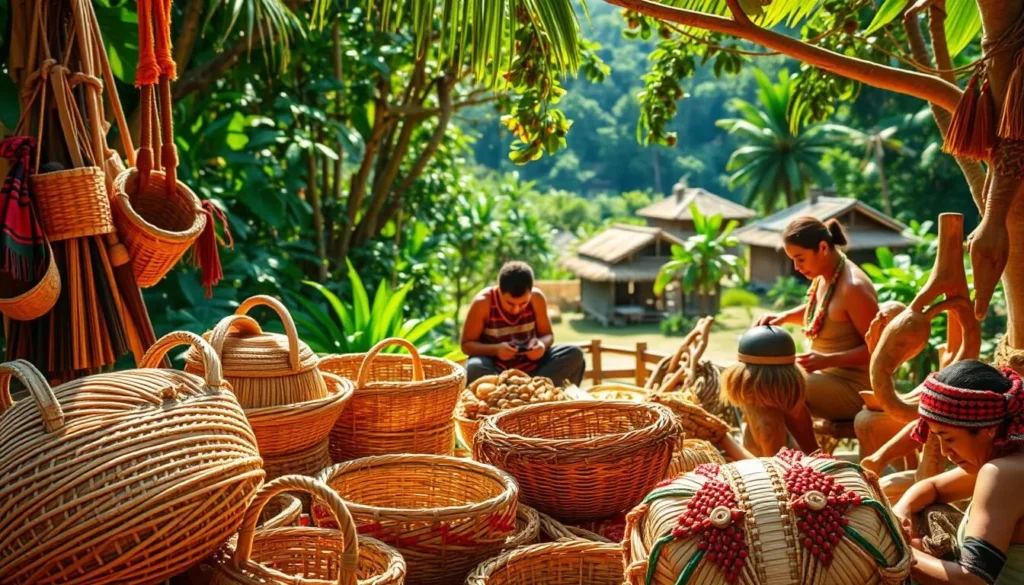
Cultural Etiquette and Respectful Tourism
Cultural sensitivity is not just a courtesy; it’s a necessity when engaging with the indigenous communities of Galibi. When visiting these areas, it’s essential to approach with respect and follow local customs to ensure a positive experience for both visitors and the local population.
When interacting with the Kaliña people, follow your guide’s instructions regarding appropriate behavior, as certain areas may hold cultural or spiritual significance. For instance, some areas may require specific protocols or dress codes. Photography should always be approached with sensitivity; ask permission before capturing images of people or cultural activities, as some traditions may have restrictions around visual documentation.
- Learn a few basic greeting words in the local language to show respect and appreciation for the culture and history of the area.
- Dress modestly when visiting indigenous villages, as conservative clothing is appreciated in many traditional communities around the world.
- Be mindful that you’re entering living communities rather than tourist attractions, so avoid behaviors that might disrupt daily life.
By being respectful and considerate, you can contribute to a positive and enriching experience for both yourself and the communities you visit.
Riverside Experiences in Galibi
The Maroni River, forming the border between Suriname and French Guiana, is a haven for nature lovers. This vital waterway not only separates but also connects these two regions, offering a unique blend of cultural and natural experiences.
Scenic Boat Rides on the Maroni River
Scenic boat rides on the Maroni River offer some of the most memorable experiences in Galibi. As you glide along the river, you’ll observe life along this important waterway that serves as the border between Suriname and French Guiana.
During your visit, consider arranging longer river excursions that take you to more remote areas where wildlife is abundant and human presence is minimal. These trips provide both practical transportation and opportunities for wildlife viewing.
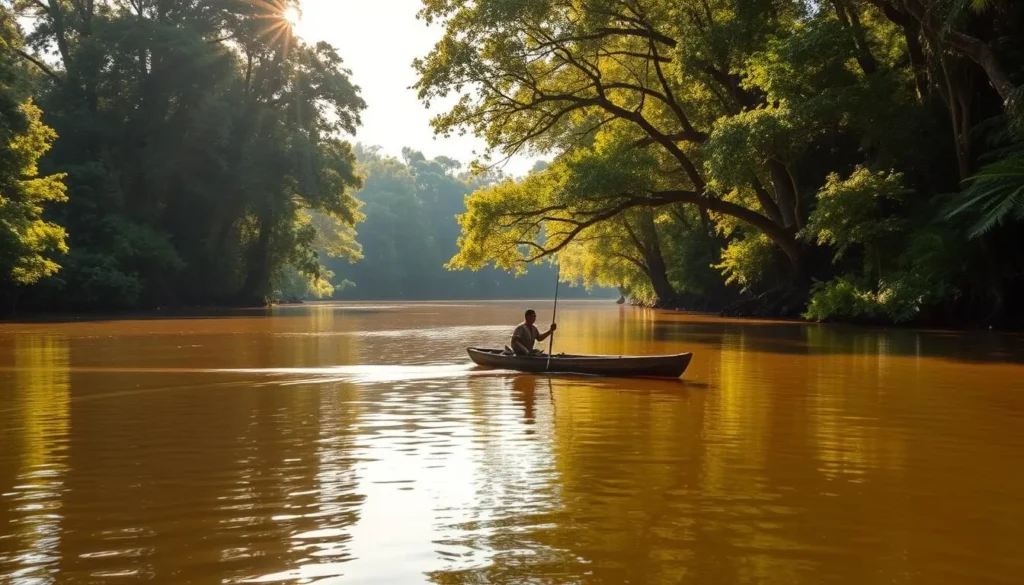
Sunset boat trips are particularly popular among visitors, as the golden light creates spectacular photo opportunities and many animals become active during this transitional time of day. Local boat operators often share fascinating stories about river life and history during these journeys, adding cultural context to the natural beauty you’ll experience.
| Activity | Duration | Highlights |
|---|---|---|
| Scenic Boat Ride | 2 hours | Wildlife viewing, scenic views |
| Sunset Cruise | 3 hours | Golden light, active wildlife |
| Multi-day River Excursion | Several days | Remote areas, abundant wildlife |
For visitors staying for multiple days, these extended excursions offer a deeper connection with the natural surroundings and local culture, making your experience in Galibi even more enriching.
Fishing Opportunities with Locals
Experience the rich fishing culture of Galibi by joining local fishermen on the Suriname River. The Marowijne River, which forms part of the Suriname River system, is home to dozens of small boats moored along its banks, where local fishermen sell fresh and dried fish.
Joining local fishermen for a day on the river provides an authentic cultural experience. You’ll learn traditional fishing techniques that have sustained communities here for generations. Fishing trips can be arranged through your accommodation or local guides, offering options ranging from a few hours to full-day adventures that include preparing and eating your catch.
Diverse Fish Species and Traditional Techniques
The rivers around Galibi support a diverse range of fish species. Locals have developed specialized techniques for different targets, reflecting their deep knowledge of aquatic ecosystems and fish behavior. Historical fishing practices in this region date back centuries, with methods adapted over time but still maintaining core traditional approaches that demonstrate sustainable resource use.
| Fishing Trip Options | Duration | Activities |
|---|---|---|
| Half-Day Trip | 4 hours | Fishing, learning local techniques |
| Full-Day Trip | 8 hours | Fishing, preparing, and eating your catch |
| Multi-Day Trip | Multiple days | Fishing, immersing in local culture, and learning daily life and food traditions |
For visitors staying multiple days, participating in fishing activities offers insights into daily life and food traditions that you wouldn’t experience through more conventional tourist activities. By joining local fishermen, you’ll gain a deeper appreciation for the history and culture surrounding fishing in Galibi.
Birdwatching Paradise: Galibi’s Avian Diversity
With its rich avian diversity, Galibi offers an unparalleled birdwatching experience. The region is home to over 250 bird species, including vibrant toucans and parrots, making it a dream destination for bird enthusiasts.
Galibi’s diverse habitats support an impressive variety of bird species, attracting visitors from around the world who come to add rare sightings to their life lists. The area’s mangroves, forests, and coastal regions create a perfect environment for a wide range of avian life.
Essential Gear for Birdwatchers
To make the most of your birdwatching trips, it’s essential to have the right gear. Quality binoculars with 8×42 magnification are ideal for spotting birds without disturbing them. A field guide specific to Suriname or northern South America will help you identify the species you encounter.
- Quality binoculars (8×42 magnification)
- Field guide specific to Suriname or northern South America
- Comfortable clothing in neutral colors
- Camera with a telephoto lens for photography enthusiasts
The best time for birdwatching activities is during the early morning and late afternoon when birds are most active and vocal. However, different species can be observed throughout the day in various habitats.
| Gear | Description | Importance |
|---|---|---|
| Binoculars | 8×42 magnification for clear viewing | High |
| Field Guide | Specific to Suriname or northern South America | High |
| Camera | With telephoto lens for capturing images | Medium |
For visitors with a particular interest in avian species, specialized birdwatching guides can be arranged. These guides provide expert knowledge that significantly increases your chances of spotting elusive birds.
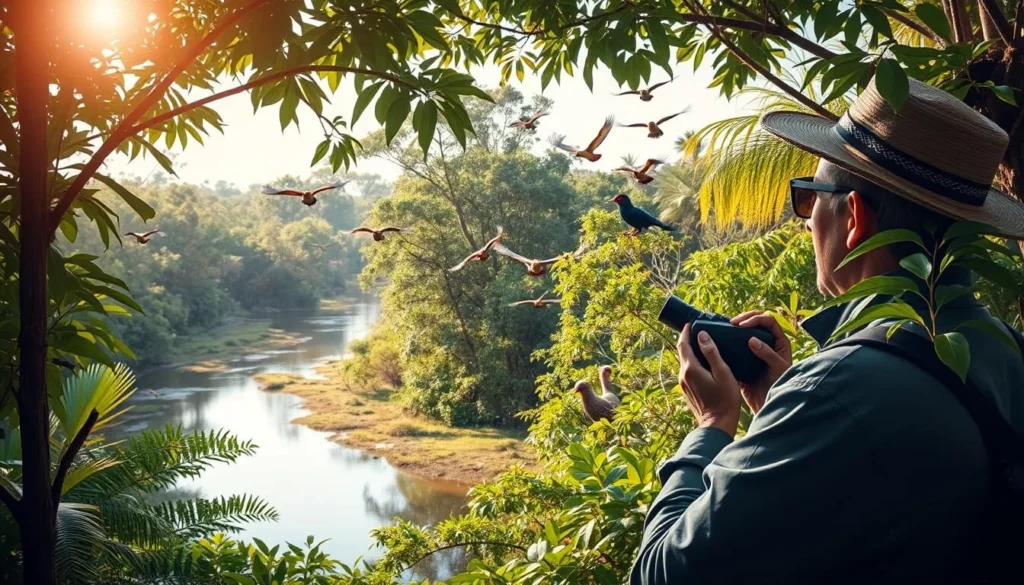
Notable Bird Species and Where to Find Them
With its diverse habitats, Galibi attracts a wide variety of bird species, making it a dream destination for enthusiasts. The region is home to over 250 bird species, including the vibrant toucans and parrots that are a delight to spot.
The coastal area of Galibi is particularly notable for its wading birds, such as herons, egrets, and the spectacular scarlet ibis. These birds are best observed during low tide when they feed on exposed mudflats. The early morning hours are ideal for spotting these birds as they are most active during this time.
In the forest edges and clearings, you can spot colorful species like toucans, parrots, and tanagers. The diverse habitats in Galibi support a wide range of birdlife, making it an exciting destination for birdwatching. Visitors can explore different habitats in a single day and yield dozens of species.
- The coastal area hosts numerous wading birds, including herons and egrets, which are best seen during low tide.
- Forest edges are prime locations for spotting colorful species like toucans and parrots, particularly during early morning hours.
- Mangrove specialists, such as the mangrove cuckoo, can be found in specific habitats, rewarding patient visitors with unique sightings.
- Migratory species add to Galibi’s bird diversity at certain times of the year, with shorebirds from North America being abundant during their non-breeding season.
A full day of birdwatching in different habitats can be very rewarding, making Galibi one of the most productive birding destinations in northern South America. Whether you are a casual or serious bird enthusiast, Galibi has something to offer.
Discovering Unique Flora in Galibi
As you explore Galibi, you’ll uncover a diverse array of flora that have been used for centuries by the indigenous Kaliña people. The region’s unique environment, with its transition zone between mangroves and inland jungle, creates a haven for diverse plant communities.
The indigenous Kaliña people have developed extensive botanical knowledge over centuries, using local plants for medicinal purposes that address a range of health issues. This traditional knowledge has been passed down through generations and continues to play a vital role in their daily lives.
Medicinal Plants and Their Traditional Uses
Guided ethnobotanical walks offer fascinating insights into traditional plant uses, with knowledgeable guides explaining how certain species have been incorporated into local healing practices and cultural traditions. Many medicinal plants found in Galibi have gained recognition in the wider world as scientists study their properties, validating traditional knowledge that has been preserved through oral history.
| Medicinal Plant | Traditional Use | Scientific Validation |
|---|---|---|
| Plant A | Treatment for fever | Antipyretic properties confirmed |
| Plant B | Wound healing | Antimicrobial properties validated |
| Plant C | Digestive issues | Anti-inflammatory properties recognized |
The rich nature of this region has produced unique plant adaptations to the coastal environment, creating a natural pharmacy that continues to be relevant in contemporary indigenous culture. Conservation efforts in Galibi include preserving not just the plants themselves but also the traditional knowledge about their uses, recognizing that cultural and natural heritage are deeply interconnected.
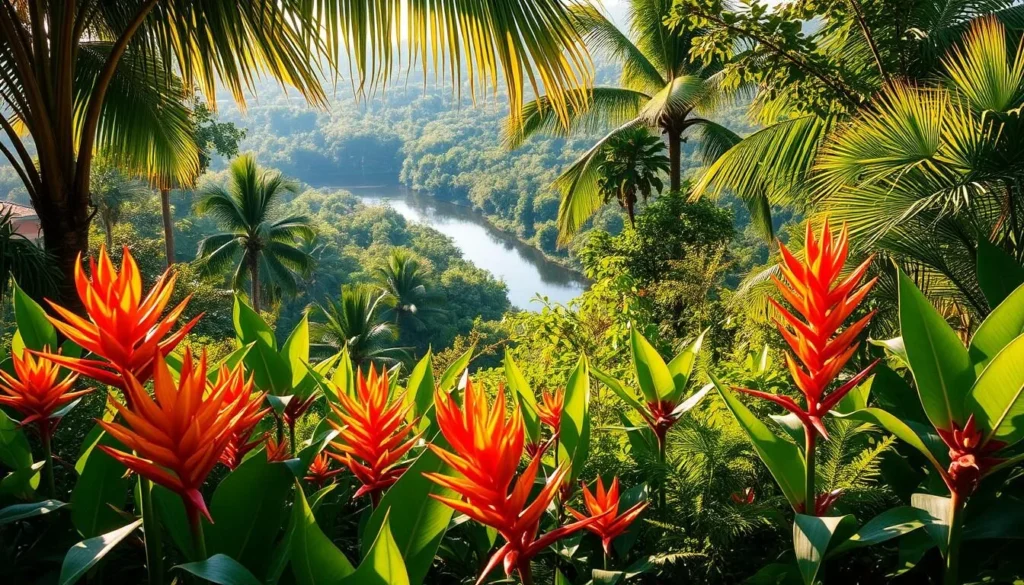
Photogenic Plant Species for Nature Lovers
The ecotone in Galibi is a treasure trove for photographers, with its diverse plant communities providing endless inspiration. As you explore this unique region, you’ll discover a variety of photogenic plant species that make for captivating subjects.
Diverse Flora for Nature Photography
Photographers visiting Galibi are drawn to the vibrant heliconias and gingers that add splashes of red and orange to the green backdrop, creating striking compositions for nature photography. The transition zone between mangroves and inland jungle creates a unique ecotone where diverse plant communities thrive, including orchids and bromeliads that grow as epiphytes on mangrove branches.
- Epiphytic orchids and bromeliads that grow on tree branches rather than in soil offer fascinating subjects for macro photography, with their intricate structures and adaptations visible upon close inspection.
- The diversity of plant species creates endless photographic opportunities throughout your trip, from the geometric patterns of fern fronds to the dramatic aerial roots of strangler figs.
- Different times of day offer varying lighting conditions that transform the appearance of the forest, with early morning mist creating an ethereal atmosphere that many photographers specifically seek out.
Capturing the Beauty of Galibi’s Flora
Guided photography walks can help visitors locate particularly photogenic specimens and learn about the ecological roles of these visually striking plants, adding depth to your photographic experience. During your trip, you’ll have ample opportunities to capture the beauty of Galibi’s diverse flora.
| Plant Species | Characteristics | Best Time to Photograph |
|---|---|---|
| Heliconias | Vibrant, waxy flowers | Early morning |
| Orchids | Intricate, delicate structures | Late afternoon |
| Gingers | Brightly colored inflorescences | Golden hour |
As you explore Galibi, remember to take your time and appreciate the natural beauty surrounding you. The unique combination of plant species and varying lighting conditions make it an ideal location for nature lovers and photographers alike.
Where to Stay in Galibi
As you plan your days in Galibi, consider the diverse range of places to stay that this beautiful region has to offer. From eco-lodges to sustainable accommodations, Galibi caters to various tastes and preferences, ensuring a comfortable stay for all visitors.
Sustainable Accommodations
Eco-tourism in Suriname is characterized by its commitment to preserving the natural environment, and Galibi is no exception. The region boasts numerous eco-lodges that not only provide comfortable stays but also contribute to the conservation of the surrounding ecosystem. These lodges are designed to blend seamlessly into the natural landscape, using local materials and traditional building techniques.
For the tourist looking for a more immersive experience, many of these eco-lodges offer guided trips into the surrounding rainforest, kayaking excursions, and other activities that allow you to engage deeply with nature. Whether you’re staying in a basic hammock setup or a luxurious private bungalow with a river view, you’ll be surrounded by the sights and sounds of the rainforest.
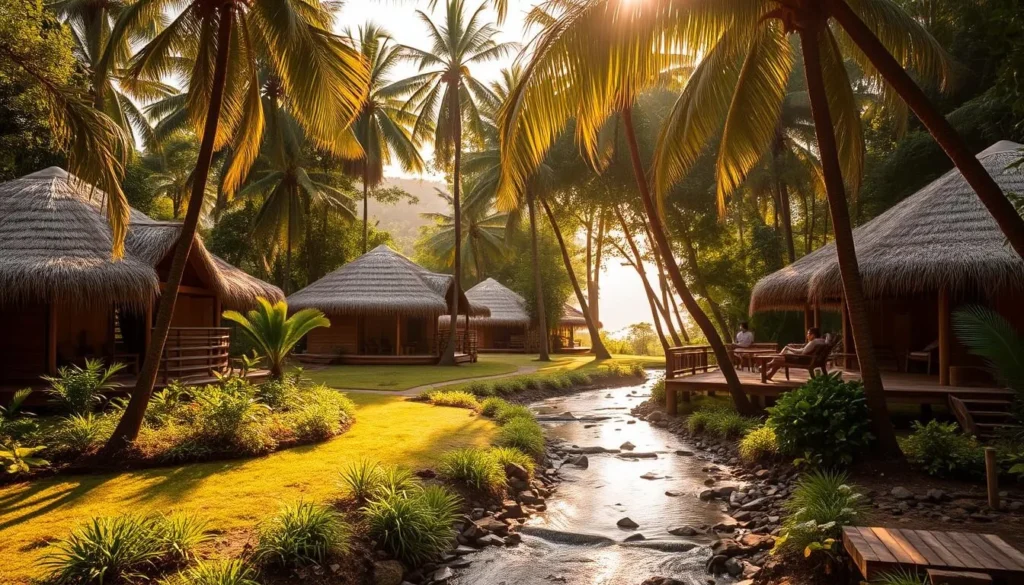
The range of accommodations in Galibi ensures that there’s something for every kind of traveler. Here are some of the options you can consider:
| Accommodation Type | Description | Price Range |
|---|---|---|
| Eco-Lodges | Environmentally friendly lodges with guided activities | Moderate to High |
| Hammock Setups | Basic, budget-friendly accommodations | Low |
| Private Bungalows | Luxurious bungalows with river views | High |
Staying in Galibi for multiple days allows you to fully experience the rhythm of life in this remote area. It’s an opportunity to participate in a wide range of activities and truly unwind in a setting far removed from the city life.
Homestay Experiences with Local Families
Immerse yourself in the indigenous way of life through homestay experiences in Galibi. By living with Kaliña families, you can gain authentic insights into the daily life and cultural practices of these communities.
Homestay experiences offer a unique opportunity to participate in daily activities, such as traditional crafts and food preparation. You can learn skills like basket weaving or fishing techniques and hear stories about the communities’ relationship with their environment.
During your stay, you might engage in language exchange with your hosts, learning basic phrases in their native language while helping them practice their language skills. The personal connections you form during your homestay can become the most treasured memories of your trip to Galibi.
| Homestay Benefits | Description |
|---|---|
| Cultural Immersion | Participate in daily activities and learn traditional skills |
| Language Exchange | Learn native language phrases and help hosts practice their language skills |
| Personal Connections | Form lasting memories through interactions with local families |
By choosing a homestay, you contribute to the local economy and experience the culture firsthand, making your trip to this part of the country truly unforgettable.
Culinary Experiences in Galibi
As you explore Galibi, Suriname, you’ll discover a culinary landscape that reflects the country’s rich cultural diversity. The cuisine in Galibi is a unique blend of traditional Surinamese dishes, influenced by the various ethnic groups that have shaped the country’s history.
Local Surinamese Dishes to Try
Surinamese cuisine is a melting pot of flavors, with dishes incorporating influences from Indigenous, African, Indian, Javanese, Chinese, and Dutch culinary traditions. Some must-try dishes include:
- Moksi-alesi, a flavorful one-pot meal featuring parboiled rice with fish or salted meat, complemented by tomatoes, black-eyed peas, and coconut milk.
- Pom, a signature Surinamese dish with Jewish origins, consisting of layers of sautéed chicken and grated potatoes mixed with lemon juice, tomatoes, nutmeg, and other local spices, baked to create a hearty casserole.
- Cassava-based dishes that reflect indigenous culinary traditions, including cassava bread and pepper pot stews that have sustained communities in this region for generations.
In Galibi, you’ll find local adaptations of these national dishes, often featuring freshly caught fish and locally grown produce that add regional character to the broader Surinamese cuisine. Be sure to try these local specialties during your visit.
The culinary experiences in Galibi offer a delicious way to explore the country’s cultural heritage. With its rich flavors and diverse influences, Surinamese cuisine is sure to leave a lasting impression on your taste buds.
Fresh Seafood and River Fish Specialties
In Galibi, you can indulge in a range of fresh seafood and river fish specialties that are deeply rooted in the local culture and cuisine. The region’s coastal location and riverine resources make it an ideal place for a diverse array of aquatic delicacies.
The local cuisine in Galibi is characterized by its use of fresh ingredients, with seafood being a prominent feature. Fresh seafood is abundant, thanks to the coastal location, and is often prepared in ways that highlight its natural flavors. You can enjoy dishes made with a variety of fish and seafood, all showcasing the richness of the ocean’s harvest.
- River fish specialties include dishes made with anjumara and other freshwater species, often served with a side of rice and local vegetables.
- Smoked and dried fish techniques are used to preserve the catch, creating distinctive flavors that are incorporated into various dishes, including hearty stews that may include chicken and root vegetables.
- Coconut milk is a common ingredient in seafood preparations, with fish simmered in coconut milk and seasoned with local herbs to create flavorful dishes that exemplify the coastal Surinamese cuisine.
- Traditional cooking methods involve wrapping fish in banana leaves before grilling or steaming, a technique that infuses the flesh with subtle flavors while keeping it moist.
One of the signature dishes you might come across is Moksi-alesi, a parboiled rice dish complemented by fish or salted meat, tomatoes, black-eyed peas, and coconut milk. This dish is a testament to the rich culinary heritage of the region, blending various flavors and ingredients into a delicious meal.
The use of local ingredients such as rice, potatoes, and chicken, alongside fresh seafood and river fish, underscores the diversity and richness of Surinamese cuisine. Whether you’re enjoying a simple meal of grilled fish or a more complex stew, the culinary experiences in Galibi are sure to leave a lasting impression.
Essential Travel Tips for Visiting Galibi
Before you head to Galibi, understanding what to pack and how to prepare can enhance your travel experience. Galibi, with its rich cultural heritage and diverse wildlife, is a destination that requires some planning to fully enjoy.
What to Pack for Your Trip
Packing the right gear is crucial for a comfortable trip to Galibi. The humid climate means that clothing that dries quickly is a must. Avoid heavy fabrics like jeans that become uncomfortable in tropical conditions. You should plan your activities according to the number of days you have in Galibi, ensuring you make the most of your trip.
Some of the essentials to include in your luggage are:
- Lightweight, quick-drying clothing to keep you comfortable in the humid climate.
- An ultralight rain/wind jacket to protect you from sudden rain showers.
- Sunglasses and sunscreen with high SPF to shield you from the intense equatorial sun during your outdoor activities in Galibi.
- A basic first aid kit with remedies for common travel ailments, such as anti-diarrhea medication and pain relievers.
- A headlamp or flashlight for navigating in the evenings, especially if you’re staying outside the main city areas or participating in night wildlife viewing activities.
- A dry bag or waterproof case for your electronics and important documents, given the likelihood of boat transportation and rain, which are common things to contend with during your Galibi adventure.
It’s also a good idea to bring insect repellent containing DEET to protect against mosquitoes and other insects. Additionally, consider packing a quick-dry towel, thermo underwear for cooler evenings, and blister plasters for any hiking or walking activities you plan to do during your trip to Galibi.
Health and Safety Considerations
To have a safe and enjoyable time in Galibi, you need to be aware of certain health and safety considerations. Before you embark on your trip, it’s crucial to consult with a travel health professional to ensure you have all the recommended vaccinations.
One of the key health considerations is the risk of malaria, particularly when visiting interior regions. Taking appropriate medication and using insect repellent consistently can help prevent this risk. Additionally, drinking only bottled or properly treated water is essential to avoid gastrointestinal issues.
- Consult a travel health professional well in advance for recommended vaccinations, including yellow fever.
- Take malaria prevention measures, such as medication and insect repellent.
- Drink bottled or treated water and avoid raw foods washed in untreated water.
- Bring sufficient prescription medications for the duration of your days in Galibi, plus extra.
- Be aware of things to do for water safety during swimming or water-based activities.
| Health Consideration | Precaution |
|---|---|
| Malaria | Medication and Insect Repellent |
| Waterborne Diseases | Drink Bottled or Treated Water |
| Medical Facilities | Bring Prescription Medications |
By being aware of these health and safety considerations, you can have a safe and enjoyable trip to Galibi.
Communication and Money Matters
To make the most of your visit to Galibi, you need to be aware of the local monetary system and communication infrastructure. The official currency of Suriname is the Surinamese Dollar (SRD). While credit cards are accepted at major hotels and restaurants in Paramaribo, cash is essential for smaller establishments and travel outside the capital.
When traveling to Galibi, it’s crucial to exchange money before leaving Paramaribo, as there are no ATMs in Galibi and credit cards are rarely accepted. You should bring enough cash to cover all your expenses for the duration of your stay, plus extra for unexpected costs or additional days if your transportation back is delayed.
Mobile phone coverage in Galibi is limited and unreliable. It’s a good idea to inform your family and friends that you may be out of contact during your visit. Some tourist accommodations offer limited Wi-Fi, though connection speeds are typically slow and service may be intermittent. If staying connected is important to you, consider purchasing a local SIM card in Paramaribo for more affordable data and calling options when you return to areas with coverage.
- The Surinamese Dollar (SRD) is the official currency, and cash is king in Galibi.
- Exchange your money in Paramaribo before heading to Galibi.
- Mobile coverage is limited, so plan your communications accordingly.
- Some accommodations offer Wi-Fi, but speeds can be slow.
- Consider a local SIM card for better connectivity when you’re back in covered areas.
Day Trips from Galibi
A day trip to Albina is a great way to experience the local culture while staying in Galibi. Albina is a town that acts as a gateway to French Guiana and the Galibi Nature Reserve.
Visiting Albina
Albina is a charming town with a rich history, located on the Surinamese side of the Marowijne River. The town has a bustling riverside market where local fishermen sell fresh and dried fish. You can learn about the town’s history through conversations with locals who experienced the tumultuous period of the 1980s and 1990s.
The riverfront area is particularly lively, with small boats constantly arriving and departing, creating a hub of activity that demonstrates the river’s continuing importance to local commerce and transportation. You can combine your visit with some shopping for practical things you might need during your stay in Galibi, as Albina has more stores and supplies than the smaller communities closer to the nature reserve.
| Things to Do in Albina | Description |
|---|---|
| Explore the Riverside Market | Experience the local culture and buy fresh fish from local fishermen. |
| Learn about the Town’s History | Talk to locals and learn about the town’s history and the impact of the 1980s and 1990s political events. |
| Shop for Supplies | Albina has more stores and supplies than the smaller communities closer to the nature reserve. |
Overall, Albina is a great destination for a day trip from Galibi, offering a unique blend of culture, history, and commerce. You can enjoy the town’s vibrant atmosphere, learn about its history, and shop for supplies, making it a great addition to your trip.
Crossing to Saint Laurent du Maroni in French Guiana
You can easily take a day trip from Galibi to Saint Laurent du Maroni, located just across the Marowijne River in French Guiana. A frequent ferry service links Albina with Saint Laurent du Maroni, making it a straightforward journey.
As you cross from Suriname into French Guiana, you’ll experience a transition from one cultural world to another. The Dutch influence in Suriname gives way to the French culture in Saint Laurent du Maroni, offering a unique day trip experience.
The ferry crossing is frequent during daylight hours, but be sure to bring your passport and check visa requirements in advance, as French Guiana is an overseas department of France. Once in Saint Laurent du Maroni, you’ll find that the town’s colonial architecture is remarkably well-preserved. The imposing former penal colony, known as Camp de la Transportation, stands as a somber reminder of the area’s dark history as a French prison settlement that operated for over a centuries.
Exploring Saint Laurent du Maroni, you’ll discover a blend of French, Creole, and Amazonian influences in the town’s market and restaurants. This unique cultural blend creates a culinary landscape distinct from what you’ll find on the Surinamese side of the river, making it a fascinating destination for trips beyond Galibi.
This cross-border experience provides valuable historical context for understanding the complex colonial history of the Guianas region, which was divided between Dutch, French, and British powers for centuries. It’s an enriching experience that broadens your perspective on the region’s diverse cultural heritage.
Conclusion: Why Galibi Should Be on Your Bucket List
If you’re looking for an authentic ecotourism destination, Galibi should be your top choice. This hidden gem in Suriname offers a rare combination of pristine nature and rich cultural heritage.
Galibi represents one of the last truly authentic ecotourism destinations in the world, where conservation, cultural preservation, and sustainable tourism work together to protect a unique natural and cultural heritage. By visiting Galibi, you’re supporting conservation efforts and sustainable development in a country that has maintained much of its natural environment intact.
The combination of wildlife encounters, particularly the awe-inspiring sea turtle nesting, with opportunities to engage with indigenous culture creates a multidimensional travel experience that includes a variety of things to see and do. You’ll have the chance to participate in exciting activities, from turtle watching tours to kayaking through mangrove ecosystems.
In conclusion, adding Galibi to your bucket list means choosing to venture beyond mainstream tourism destinations to discover one of South America’s hidden treasures, where authentic experiences and natural wonders await the adventurous traveler.
—
The above is subject to change.
Check back often to TRAVEL.COM for the latest travel tips and deals.
